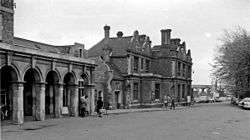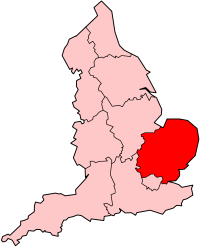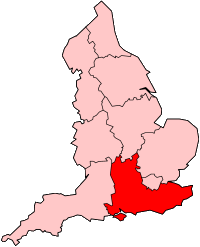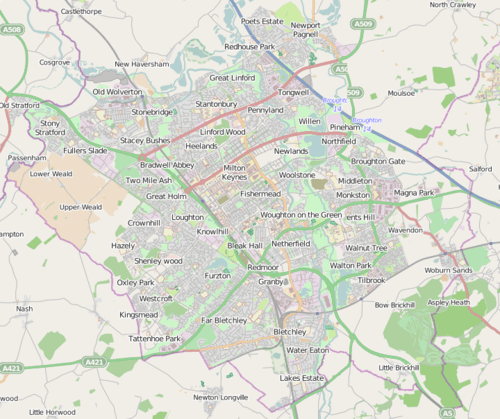Varsity Line
| Varsity Line | |
|---|---|
 Bletchley station, at the midpoint of the line, in 1962 | |
| Overview | |
| Type | Heavy rail |
| System | National Rail |
| Status |
Operational: Bletchley–Bedford, Oxford–Bicester Village Rebuild scheduled: Bicester Village–Bletchley Closed: Bedford–Sandy–Cambridge |
| Locale | South East England |
| Termini |
Oxford Bedford |
| Stations |
13 open 2 planned |
| Operation | |
| Opened | 1846–1851 |
| Closed |
1968: Bedford to Cambridge; Oxford-Bletchley (to Passengers) 1993:mothballed Claydon Junction–Bletchley (to all traffic) |
| Owner | Network Rail |
| Operator(s) |
Chiltern Railways (Oxford–Bicester) London Midland (Bletchley–Bedford) |
| Technical | |
| Number of tracks | 1–2 |
| Track gauge | 1,435 mm (4 ft 8 1⁄2 in) standard gauge |
The Varsity Line (or Oxford to Cambridge line) is the railway route that used to link the English university cities of Oxford and Cambridge, operated successively by the London and North Western Railway, the London, Midland and Scottish Railway, and British Railways.
Services were withdrawn from the Oxford–Bletchley and Bedford–Cambridge sections at the end of 1967, even though the line had not been listed for closure as part of the Beeching Axe in 1963. Only the Bletchley–Bedford section remained open for passenger traffic.
Proposals to reopen the route began to gain momentum in the 2000s, led by the "East West Rail Link" consortium. As of the end of 2016, the section between Oxford and Bicester Junction (for Chiltern Main Line to Marylebone) has reopened; East West Rail Ltd has a (funded) schedule to rebuild the mothballed section between Bicester and Bletchley.[1][2]
In the absence of a rail service, Stagecoach in Bedford's X5 coach service provides a passenger service by road between Oxford and Cambridge via Bicester, Milton Keynes and Bedford.
History
The line was built in two stages, the first by the Buckinghamshire Railway between Oxford and Bedford in 1845. and the second by the Bedford and Cambridge Railway which opened on 7 July 1862.
Bedford and Cambridge Railway
Proposed from 1844, the supporting and surveying engineers were George and Robert Stephenson. The engineers' proposal to junction with the London and Birmingham Railway at Bletchley was eventually accepted by the shareholders, with construction starting in December 1845 and completed by September 1846. All operations were subcontracted to the LNWR.
Buckinghamshire Railway
The Bletchley and Bedford section was opened by the Buckinghamshire Railway in 1846. It then opened the section between Bletchley and Verney Junction on 30 March 1850 as part of its line to Banbury,[3] and the section between Verney Junction and Oxford on 20 May 1851.[3]
L&NWR/LMS
By the time that the B&CR had been built, the London and Birmingham Railway amalgamated with the Grand Junction Railway to form the London & North Western Railway (LNWR), who immediately took over the running rights to the line. The LNWR bought-out the B&CR in 1865. From 1 July 1851, the LNWR operated the Buckinghamshire Railway on a 999-year lease, then absorbing the company on 21 July 1879.[3]
However, although it now owned and operated the complete line, the LNWR chose to operate it as two separate timetables, using Bletchley as originally planned as an intermediate station, with separate trains running in two directions: east to Cambridge; and west to Oxford. It was not until it was amalgamated in 1922 that the London Midland and Scottish Railway started running complete services from Oxford to Cambridge.
During World War II, the line carried many trains to and from the Bicester Military Railway. A junction between the line and the Great Central Main Line was built between Calvert and Claydon to improve connection.
British Railways
After nationalisation in 1948 into British Railways, an early attempt to close the line in 1959 failed owing to local opposition. The line was not listed for closure in the 1963 The Reshaping of British Railways report.[4] Patronage of the line fell when the introduction of fast trains from London to Oxford and Cambridge made it quicker for passengers to go via London. At the end of 1967 BR withdrew passenger services from the Oxford – Bletchley section and all trains from the Bedford – Cambridge section, a year after it had withdrawn passenger services north of Aylesbury on the Great Central Main Line.
In the 1980s the line between Aylesbury and Bletchley via Calvert was used for transfers of empty passenger rolling stock due to the closure of the London Marylebone depot, thus transferring the maintenance of the Chiltern Line's Class 115s to Bletchley. This ceased with the opening of a new depot in Aylesbury and the introduction of the Class 165. During 1982 the entire length of the Bletchley-Oxford section, which was still double-tracked throughout, was used for diversionary passenger services while a bridge at Hill Wooton, between Coventry and Leamington Spa was replaced; all Birmingham-London Paddington services scheduled to stop at Coventry being diverted via this route for three days. Also in the 1980s, there were passenger specials to Milton Keynes from Marylebone via Aylesbury and High Wycombe, which picked up passengers at disused Winslow.[5] The last passenger train to operate on this section of the line was the Mothball Tour on 29 May 1993, just before the line was taken out of use.[6]
Network SouthEast, supported by Oxfordshire County Council, reopened the Oxford – Bicester Town section to passenger traffic in 1987, and reopened Islip railway station in 1989.[7] From 15 February 2014, this link closed again for a major upgrade as described below.
Status of route prior to commencement of East West Rail project

The Oxford to Bicester line closed in 2014 for major upgrades and reopened (from Bicester Village as far as Oxford Parkway) in October 2015: the remaining segment to Oxford reopened in December 2016.[8] The rebuilt line is mostly 100 mph (160 km/h) double track (see Chiltern Railways#Evergreen 3). Between Bicester Village and Newton Longville the route is in place but derelict. Within this stretch (starting 1 February 2014), Network Rail began clearing vegetation that had grown over the abandoned track.[9] The stretch between Newton Longville and Bletchley was re-laid in spring 2006 and opened on 27 March 2006 for freight traffic, carrying refuse to the Newton Longville landfill site. Between Bletchley and Bedford the track is open and in daily passenger use as the Marston Vale line.
Between Bedford and Cambridge all of the track has been removed[10] and some sections of the trackbed have been lost. At Sandy and Potton new housing occupies the former route. Between Lord's Bridge and Cambridge, the Ryle Telescope of Mullard Radio Astronomy Observatory now occupies a 3-mile (4.8 km) length of the former route. Between Trumpington Park and Ride and Cambridge Station the entire route has been converted to be part of the Cambridgeshire Guided Busway.
Revival plans
This is a brief summary of work underway to reestablish the route. For details, see the main EWR article.
Completed works
The section from Oxford to Bicester Village became operational from December 2016.
Confirmed plans
In the 2011 Autumn Statement by Chancellor George Osborne, the East West railway between Oxford, Aylesbury Vale Parkway and Bedford was approved and funded, with £270 million committed to the scheme.[11] This development was anticipated to be complete by 2017,[12] but has been rescheduled to Control Period 6 (i.e. 2019 to 2024).[13]
Prognosis for Bedford–ECML

Network Rail is authorised to develop a proposal for a route from Bedford to the East Coast Main Line via Sandy.
Prognosis for ECML–Cambridge
In November 2016, Chancellor of the Exchequer, Philip Hammond announced funding for a route plan to Cambridge.[14]
See also
| Wikimedia Commons has media related to Varsity Line. |
Notes
References
- ↑ "Chancellor accepts East West Rail targets and strengthens plans with extra cash". www.railtechnologymagazine.com.
- ↑ Transport Secretary officially launches East West Railway Company at Bletchley Park East West Rail, 22 November 2017
- 1 2 3 Awdry (1990) p. 63
- ↑ Chris Grayling’s Oxford-Cambridge line will clatter through 75 miles of English history – Ian Jack, The Guardian, 10 December 2016
- ↑ "The Quaintonian". The Railcar Association. Archived from the original on 20 July 2008.
- ↑ Brown, Murray, ed. (May 12, 1993). "Class 56 special over 'doomed' Bletchley flyover line". RAIL (200): 6.
- ↑ Bevan, Alan (Ed). A–Z of Rail Reopenings. Warwick: Railway Development Society. ISBN 0-901283-13-4.
- ↑ Oxford to London Marylebone railway line opens – BBC News, 11 December 2016
- ↑ Work starts on clearing line for East West Rail – Buckingham Today, 1 February 2014
- ↑ Reconnecting the Varsity Railway Oxford Today (University of Oxford), 12 February 2016
- ↑ Rail Magazine, Issue 685, 14 – 28 December 2011, Pages 10–11
- ↑ East West Rail could be running by 2017 – East West Rail Consortium, December 2011
- ↑ Report from Sir Peter Hendy to the Secretary of State for Transport on the replanning of Network Rail's Investment Programme – Network Rail, 25 November 2015 (pdf)
- ↑ Autumn statement: Chancellor invests in new transport links for the region – ITV Anglia, 23 November 2016
Sources
- Awdry, Christopher (1990). Encyclopaedia of British Railway Companies. Sparkford: Patrick Stephens Ltd. ISBN 1-8526-0049-7. OCLC 19514063. CN 8983.
- Butt, R. V. J. (1995). The Directory of Railway Stations: details every public and private passenger station, halt, platform and stopping place, past and present (1st ed.). Sparkford: Patrick Stephens Ltd. ISBN 978-1-85260-508-7. OCLC 60251199.
- Jenkins, Stanley C. (2013). Oxford, Bletchley & Bedford Line Through Time. Amberley Publishing. ISBN 9781445617480.
- Jowett, Alan (March 1989). Jowett's Railway Atlas of Great Britain and Ireland: From Pre-Grouping to the Present Day (1st ed.). Sparkford: Patrick Stephens Ltd. ISBN 978-1-85260-086-0. OCLC 22311137.
- Simpson, Bill. The Oxford To Cambridge Railway: Forty Years On 1960–2000. Witney: Lamplight Publications. ISBN 1-899246-05-3. OCLC 54047797.


